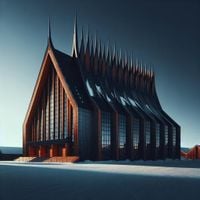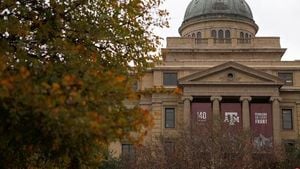In the far reaches of Swedish Lapland, some 200 kilometers above the Arctic Circle, a remarkable feat of engineering and reconciliation has unfolded. The historic Kiruna Church, a wooden edifice renowned for its inclusive spirit and multicultural embrace, has been carefully relocated to a new home. This move, necessitated by the relentless advance of the world’s largest underground iron-ore mine, marks not just a physical journey but a symbolic one for a community grappling with its past and forging a more inclusive future.
Kiruna Church—known as Kiruna Kyrka in Swedish—has stood as a spiritual and cultural anchor since its founding in 1912. Built as a gift from the state-owned mining company LKAB, the church was intended from the outset to welcome every member of the community, regardless of religious background. According to the Associated Press, the church’s architecture reflects this ethos: its exterior emulates the local Sami style, and inside, there is only a single cross, a conscious decision to avoid overemphasizing Christianity and instead foster a sense of belonging for all.
But what truly sets Kiruna Church apart is its commitment to linguistic and cultural inclusion. While Swedish is the primary language of worship, services also incorporate Northern Sami, Finnish, and Meänkieli—languages spoken by the region’s Indigenous and minority communities. "We are talking about the language of the heart," vicar Lena Tjärnberg told the Associated Press. "That’s very important, that you can hear some of the words in your language." For many, hearing sacred texts and prayers in their mother tongue is more than a gesture—it’s a recognition of identity and a balm for old wounds.
The church’s design further underscores its unique character. The 1912 altarpiece, painted by Prince Eugen—a member of the Swedish royal family and a celebrated landscape artist—depicts not a biblical scene, but a sunlit forest grove. Nature, rather than traditional religious iconography, is elevated as spiritual, reflecting the deep connection between the people of Lapland and the land itself. The scent of tar, used to preserve the church’s wooden beams, lingers in the pews, evoking generations of worshippers who have found solace within its walls.
This summer, the church’s journey became literal. With the iron-ore mine threatening to swallow the town, Kiruna Church was closed a year ago in preparation for a delicate, 5-kilometer relocation eastward. The move, completed on August 20, 2025, was no small undertaking. Yet for the people of Kiruna, ensuring the church’s survival was non-negotiable. As reported by Devdiscourse, the church is now safely settled in Kiruna’s revamped downtown, where it will continue to serve as a beacon of continuity and reconciliation.
Worshippers are expected to return to the church’s pews by the end of 2026, resuming traditions that, for many, have marked every stage of life. "You start from when you were a child, a baby, all your life until you get old," said Anna-Kristina Simma, a Sami worshipper who grew up attending Kiruna Church, in an interview with the Associated Press. The church’s significance is not limited to weekly services; it is a gathering place for weddings, funerals, and the rhythms of community life.
For Monica Nutti Blind, a deacon and member of the Sami people, the church’s architecture is a living metaphor for the region’s seasons. "The dark wood inside is like the long, dark northern Swedish winters," she reflected to the Associated Press, "but the windows allow the summer’s Midnight Sun to brighten everything. If you look up in the church, you see the light that reminds of spring and the light and the vegetation." It’s a poetic reminder of the interplay between darkness and light, tradition and renewal.
Yet Kiruna Church’s story is also entwined with a painful chapter in Swedish history. The Church of Sweden, which oversees Kiruna Church, was complicit for decades in the oppression of the Sami people—Europe’s only recognized Indigenous group. Beginning in 1913, the church and state ran so-called "nomad schools," mandatory segregated boarding schools where Sami children were subjected to racism, bullying, and efforts to erase their language and culture. These schools persisted until the 1960s, leaving deep scars that endure to this day.
In 2021, the Church of Sweden’s archbishop delivered a formal apology for the church’s role in this cultural suppression. "Within the Church of Sweden, Sami spirituality was despised. Instead of recognizing the image of God in our Sami sisters and brothers, we tried to remake them in the image of the majority culture," Archbishop Antje Jackelén said, as quoted by the Associated Press. "We did not see your obvious relationship with the Creator and with the lands. We did not understand that Sami spirituality expresses itself in everyday actions." The apology was a significant step, but the legacy of harm is still being reckoned with. A government-appointed truth commission, established in 2021, is expected to conclude its work on the lasting trauma of the nomad schools by December 1, 2025.
The church’s recent move was marked by both solemnity and hope. On August 17, 2025, two days before the relocation began, a small lakeside service was held 87 kilometers northeast of the original church site. Six worshippers gathered, bundled against the 10-degree Celsius chill, singing hymns and listening as Nutti Blind read from the Book of Proverbs in Northern Sami. The service, though brief, was imbued with a sense of continuity. Before concluding, Nutti Blind offered a prayer in Swedish: "We pray for the move of the Kiruna Church, that the church will be preserved and that the move goes well. And that we once again will use this beautiful church."
As the church settles into its new home, it stands as a testament to resilience and reconciliation—a place where the wounds of the past are acknowledged, and a more inclusive future is being forged. The journey of Kiruna Church, both physical and spiritual, continues to inspire those who call this northern town home. And for the Sami and other minority communities, hearing their languages and traditions honored within these wooden walls is a sign that, at last, their voices are being woven into the fabric of Swedish Lapland’s story.




